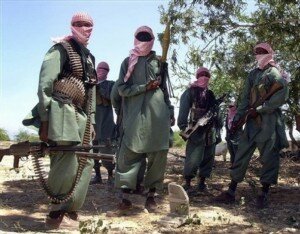What To Do With Unemployed Terrorists
 November 27, 2012: Many al Shabaab have fled to the southwest and to Puntland in the north. There, the Islamic terrorists are trying to take control of towns and the local economy, to obtain income and finance a larger force. While able to extort food and shelter in small villages, attempts to take over towns has met with stiff resistance by local militias and government forces. These two areas have attracted some of the most hardcore al Shabaab, including many foreigners. This gives peacekeepers and government troops two separate jobs; shutting down the new concentrations of al Shabaab in Puntland and the southwest, and clearing out the remaining al Shabaab garrisons in central Somalia.
November 27, 2012: Many al Shabaab have fled to the southwest and to Puntland in the north. There, the Islamic terrorists are trying to take control of towns and the local economy, to obtain income and finance a larger force. While able to extort food and shelter in small villages, attempts to take over towns has met with stiff resistance by local militias and government forces. These two areas have attracted some of the most hardcore al Shabaab, including many foreigners. This gives peacekeepers and government troops two separate jobs; shutting down the new concentrations of al Shabaab in Puntland and the southwest, and clearing out the remaining al Shabaab garrisons in central Somalia.
Al Shabaab gangs still control most of the interior in central Somalia. Government troops, local militias and AU (African Union) peacekeepers are going after the towns and major villages one at a time. Local militia take control once al Shabaab is driven from a place. Peacekeepers remain available to assist militias that are again attacked by the Islamic terrorists. That does not happen often because most al Shabaab men are demoralized and tend to just desert after a major defeat. The most dangerous al Shabaab gangs are the ones with a lot of foreigners. Some of these guys are quitting, but many of them really have nowhere else to go.
Unable to get the ransom they wanted, pirates holding a UAE owned tanker captured ten months ago (off Oman) called the families of 17 Indian sailors (most of the 22 man crew) and threatened to start killing their Indian captives if they do not get the demanded ransom by November 30th. Pirates are increasingly beating or killing captive sailors if they do not get the ransom they want. The pirates are demanding higher ransoms because they are capturing fewer ships and the shipping companies are not cooperating.
Al Shabaab sponsored terror attacks in Kenya have created a backlash against the Somali population there. There is growing hostility between Kenyan Christians and Somalis. About ten percent (4 million) of Kenyans, mostly along the coast, are Moslems and most of these are ethnic Somalis. There has always been some Islamic radical activity among Kenyan Moslems, but the police have been particularly attentive to it since Kenyan Moslems were found to be involved in terrorist operations in the 1990s. What the police have not done, however, is make much of a dent in the criminal infrastructure that supports smuggling, money laundering, a black market for guns, IDs and drugs and much else. The cops are often bought off, and the criminal gangs provide support for terrorist operations, mainly in Somalia. For example, a lot of the pirate ransom money ends up in Kenya, either for purchases of goods shipped to Somalia, or to be laundered and invested. Wealthy Somalis often find it prudent to go into exile, and Kenya is a popular place to retire to. Then there are the overseas Somalis. Most of these are in Britain (300,000) and the United States (150,000). There are also half a million Somali refugees in northern Kenya and several hundred thousand more in places like Ethiopia and Yemen. Somali Islamic radicals often send their families into exile, to protect them, and some Islamic radicals have themselves gone into exile. There, Somali men, usually young (teenager to early 20s), are recruited and sent back to Somali for more indoctrination and training. Some are killed there, and some return to the U.S. and Britain to help with recruiting and, it is feared, to carry out terrorist attacks. The Somali Islamic radicals have also been recruiting from among Kenya’s Moslem population. This recruiting has stopped in the last year, because of the many defeats al Shabaab has suffered in that time. But many radicalized young Somalis are still living among the refugees and Moslem populations of Kenya. Police attempts to find and arrest Islamic radicals are often clumsy and result in innocents being rounded up or killed. This just creates more anger in the Moslem neighborhoods.
November 26, 2012: In Mogadishu a major businessman (Ahmed Nure Awdiini) was shot dead outside his offices. Police quickly arrested over a hundred people for questioning in one of the most vigorous investigations seen here in some time. A few dozen major merchants like Awdiini have been pillars of the city economy for the last two decades. It’s uncertain if this killing was al Shabaab related, as there are still a lot of gangsters in the city.
November 24, 2012: In the southwest, near the Kenyan border, dozens of al Shabaab gunmen attacked the town of Bulohawo. The attackers were driven off after several hours of fighting and at least a dozen dead. The town was defended by local militia and reinforcements from nearby Somali army units.
November 21, 2012: The UN renewed, for another year, authorization for anti-piracy operations off Somalia. These UN backed patrols have been authorized since 2008.
November 20, 2012: Three pirates were arrested by local police in Puntland. This is where most pirate gangs are based and local police have become more active against pirates operating outside the pirate-controlled towns along the coast.
November 19, 2012: In northeastern Kenya (Garissa) two soldiers were killed in an ambush apparently conducted by al Shabaab gunmen. Soldiers in the area run support operations for Kenyan peacekeepers across the border in Somalia.
November 18, 2012: In Nairobi, Kenya a bomb went off in a bus, killing seven and wounded several others. Al Shabaab was suspected and this attack triggered mob attacks against ethnic Somalis. This led to several days of unrest that caused dozens of casualties including at least ten dead.
November 17, 2012: Kenyan counter-terror police have found several hideouts where Kenyans (usually ethnic Somalis) who had joined al Shabaab in Somalia over the last few years have taken refuge after returning from Somalia. The large number of defeats al Shabaab has suffered in Somalia over the last year has left many of their gunmen unemployed. Even “volunteer” al Shabaab members required cash (for food and other supplies) to sustain them and as al Shabaab lost sources of income (especially in towns and cities they once controlled) thousands of members were cut loose. Some became bandits, but most went home. Those from Somalia went back to their families or clans. Foreigners usually left the country and returned home or, more rarely to another terrorist sanctuary (there aren’t many of those left).
In the north (Puntland) police captured two wanted al Shabaab leaders along with a supply of bomb making materials. This was apparently part of an al Shabaab plan to attack government leaders and offices in Puntland.
November 16, 2012: In northeastern Kenya (Garissa) two policemen were killed when suspected al Shabaab gunmen opened fire on a police patrol.
Source:- strategy page
Comments
comments
 Calendar
Calendar






































